![]()
CHAPTER 2 - ENVIRONMENTAL AND CULTURAL SETTING: THE OPPORTUNITY FOR A COMPARATIVE STUDY
2.5. People, time, and labor: the annual cycle of rural production systems in Machadinho and Anari
The major actors transforming landscape in Machadinho and Anari are settlers, loggers, and rubber tappers. A critical discussion of their role in affecting LULC change is discussed in Chapter 6. This section describes how they allocate their time through the year, adjusting their activities to seasonality. Information to build this scenario was obtained from archival work and interviews with landowners, loggers, and rubber tappers during fieldwork. Several organizations related to these activities were also visited in 1999 and 2000: farmers' associations, logging companies, the local rubber tappers' association, extension and agricultural research agencies, the agrarian reform agency, governamental offices (e.g., county agricultural sections and banks), and non-governmental organizations. A general overview of farming and extraction activities is summarized in Table 3. The table shows only the most important products and activities.
Table 3 - Farming and extraction activities in the rural areas of Machadinho d'Oeste and Vale do Anari.
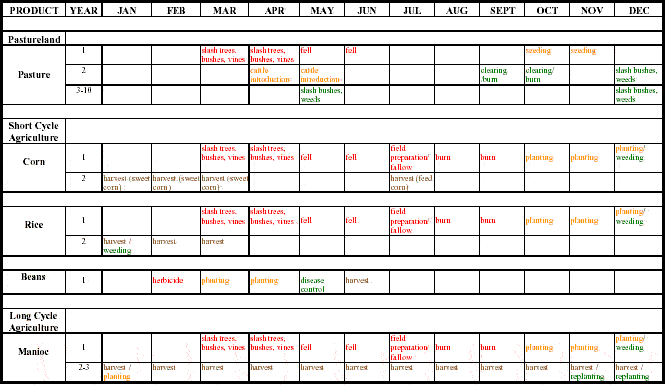
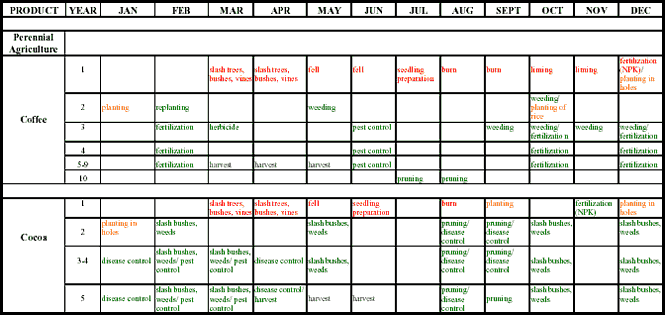
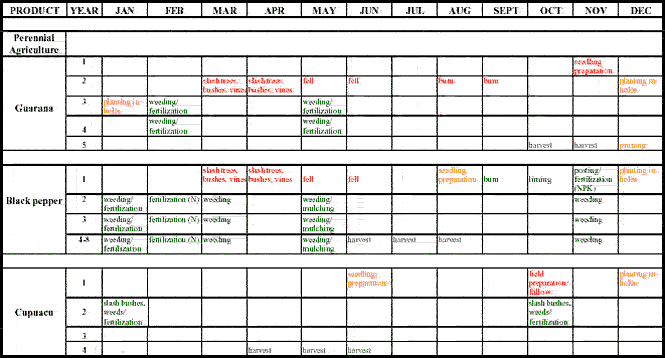
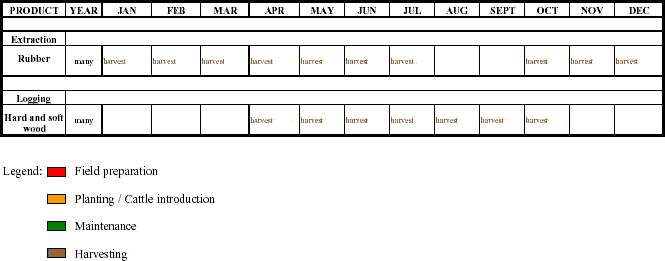
Previous works have described how farming systems have been differentiated in the study area (Miranda and Mattos 1993, Miranda et al. 1997). The trajectory seems to go from an early stage of colonization with all kinds of initial experiences to a more homogeneous situation after a decrease in the variety of farming systems. The pattern indicates agricultural intensification, which is discussed in following chapters. Farming systems are mainly household-based, and little depends on group efforts. Twenty local associations were created within the settlement but most of them are inactive or have little influence on farming decision-making. The only cooperative is an active smallholder organization and currently has 200 members.
After fifteen years of colonization, five main farming systems can be distinguished (Miranda et al. 1997a):
The existence of these farming systems was confirmed during fieldwork through interviews with landowners and visits to their properties. The occurrence of cultivation systems within the farming systems is summarized in Table 4.
Table 4 - Occurrence of cultivation systems within the farming systems in Machadinho d'Oeste and Vale do Anari.
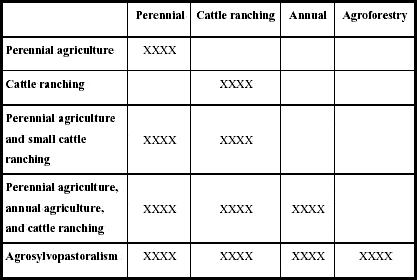
Communal forest reserves in Machadinho are State Reserves decreed by the government in 1994 and 1995, legalizing the situation of many families of rubber tappers (Olmos et al. 1999). In 1996 and 1997, governmental and non-governmental organizations established management plans for the reserves (Rondônia 1997). The plans were approved by the local rubber tappers association. Institutional arrangements concerning the reserves and their role in land cover are discussed in Chapter 6. This section mentions just the main activities of families living in those areas.
Rubber extraction from native trees is the main source of income of rubber tappers in the study area. In general, each household explores three to six trails containing 100 to 300 trees each. The production of rubber varies from 150 to 300 kg per month per family (Rondônia 1996c). The extraction is made in the early morning and sometimes in the afternoon throughout the year, with exception to the driest months (mainly August)(see Table 3). Other extractive activities, such as copaíba (Copaifera sp) oil harvesting and seed collection, are less important in the communities. The communities also plant manioc (their main staple food), subsistence annual crops (corn, rice, and beans), and small coffee plantations.
Logging activities were always associated with the opening of new colonization frontiers in the Amazon (Schminck and Wood 1992). Loggers play a major role in providing access to remote areas within the settlement as they open trails through the forest to reach valuable species. Doing so, they also disturb extensive forest patches and increase their flammability (Nepstad et al. Flames 1999).
Unfortunately, logging activities in Machadinho and Anari still follow the predatory scheme. Stimulated by market demands, loggers take the larger and most valuable trees without worrying about maintaining the vegetation structure. In general, the leftover vegetation is a forest remnant degraded in structure and species composition (Rondônia 1996a). Only recently, management plans began to be implemented, both in private properties and in communal lands. In all cases, logging is also dependent on access and seasonality because trafficable roads are necessary for taking the wood to sawmills. In the study area, this is usually possible only from May to September, but also in April and October in dryer years (Table 3).
The next chapters discuss in detail how the landscape has been transformed through the introduction of rural production systems in Machadinho and Anari following settlements' implementation. The actions and interactions of settlers, rubber tappers, and loggers are particularly important in generating such outcomes.